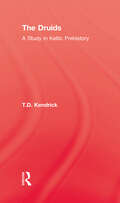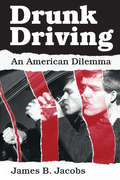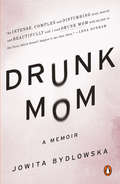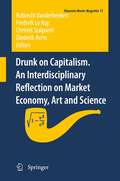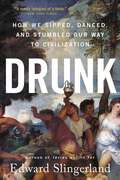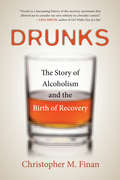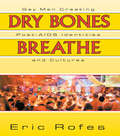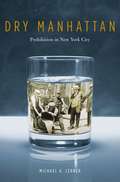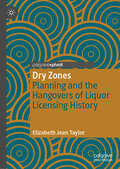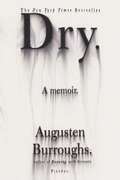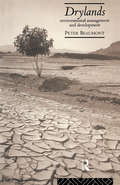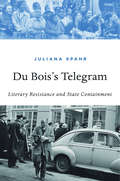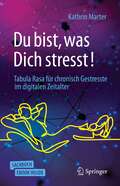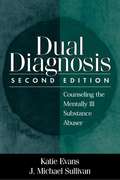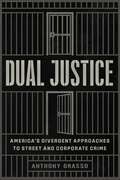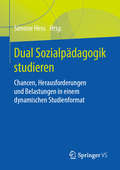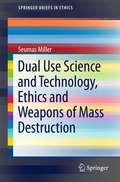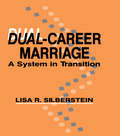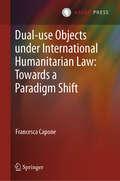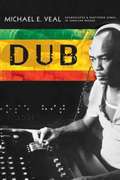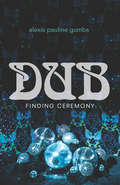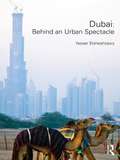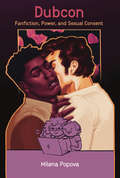- Table View
- List View
Druids
by KendrickFirst published in 2005. Routledge is an imprint of Taylor & Francis, an informa company.
Drunk Driving: An American Dilemma
by James B. JacobsIn this ambitious interdisciplinary study, James B. Jacobs provides the first comprehensive review and analysis of America's drunk driving problem and of America's anti-drunk driving policies and jurisprudence. In a clear and accessible style, he considers what has been learned, what is being done, and what constitutional limits exist to the control and enforcement of drunk driving.
Drunk Mom
by Jowita BydlowskaA bestseller in its native Canada, Drunk Mom is a gripping, brutally honest memoir of motherhood in the shadow of alcoholism Three years after giving up drinking, Jowita Bydlowska found herself throwing back a glass of champagne like it was ginger ale. It was a special occasion: a party celebrating the birth of her first child. It also marked Bydlowska's immediate, full-blown return to crippling alcoholism. In the gritty and sometimes grimly comic tradition of the bestselling memoirs Lit by Mary Karr and Smashed by Koren Zailckas, Drunk Mom is Bydlowska's account of the ways substance abuse took control of her life- the binges and blackouts, the humiliations, the extraordinary risk-taking- as well as her fight toward recovery as a young mother. This courageous memoir brilliantly shines a light on the twisted logic of an addicted mind and the powerful, transformative love of one's child. Ultimately it gives hope, especially to those struggling in the same way.
Drunk on Capitalism. An Interdisciplinary Reflection on Market Economy, Art and Science
by Christel Stalpaert Frederik Le Roy Robrecht Vanderbeeken Diederik AertsThe book presents an interdisciplinary collection of analyses that discuss the impact of market economy on our culture in the post-Berlin Wall era. It contains two parts. The first focuses on the commercialisation of science and education. The second elaborates on the multiple and diverse relation between art and capital.
Drunk: How We Sipped, Danced, and Stumbled Our Way to Civilization
by Edward SlingerlandA "entertaining and enlightening" deep dive into the alcohol-soaked origins of civilization—and the evolutionary roots of humanity&’s appetite for intoxication. (Daniel E. Lieberman, author of Exercised) While plenty of entertaining books have been written about the history of alcohol and other intoxicants, none have offered a comprehensive, convincing answer to the basic question of why humans want to get high in the first place. Drunk elegantly cuts through the tangle of urban legends and anecdotal impressions that surround our notions of intoxication to provide the first rigorous, scientifically-grounded explanation for our love of alcohol. Drawing on evidence from archaeology, history, cognitive neuroscience, psychopharmacology, social psychology, literature, and genetics, Slingerland shows that our taste for chemical intoxicants is not an evolutionary mistake, as we are so often told. In fact, intoxication helps solve a number of distinctively human challenges: enhancing creativity, alleviating stress, building trust, and pulling off the miracle of getting fiercely tribal primates to cooperate with strangers. Our desire to get drunk, along with the individual and social benefits provided by drunkenness, played a crucial role in sparking the rise of the first large-scale societies. We would not have civilization without intoxication. From marauding Vikings and bacchanalian orgies to sex-starved fruit flies, blind cave fish, and problem-solving crows, Drunk is packed with fascinating case studies and engaging science, as well as practical takeaways for individuals and communities. The result is a captivating and long overdue investigation into humanity's oldest indulgence—one that explains not only why we want to get drunk, but also how it might actually be good for us to tie one on now and then.
Drunks: An American History
by Christopher M. FinanA social history of alcoholism in the United States, from the seventeenth century to the present dayToday, millions of Americans are struggling with alcoholism, but millions are also in long-term recovery from addiction. Alcoholics Anonymous and a growing number of recovery organizations are providing support for alcoholics who will face the danger of relapse for the rest of their lives. We have finally come to understand that alcoholism is a treatable illness. But in the beginning, our nation condemned drunks for moral weakness. President John Adams renounced his alcoholic son, Charles, and refused to bury him in the family crypt.Christopher Finan reveals the history of our struggle with alcoholism and the emergence of a search for sobriety that began among Native Americans in the colonial period. He introduces us to the first of a colorful cast of characters, a remarkable Iroquois leader named Handsome Lake, a drunk who stopped drinking and dedicated his life to helping his people achieve sobriety. In the early nineteenth century, the idealistic and energetic “Washingtonians,” a group of reformed alcoholics, led the first national movement to save men like themselves. After the Civil War, doctors began to recognize that chronic drunkenness is an illness, and Dr. Leslie Keeley invented a “gold cure” that was dispensed at more than a hundred clinics around the country. But most Americans rejected a scientific explanation of alcoholism. A century after the ignominious death of Charles Adams came Carrie Nation. The wife of a drunk, she destroyed bars with a hatchet in her fury over what alcohol had done to her family. Prohibition became the law of the land, but nothing could stop the drinking.Finan also tells the dramatic story of Bill Wilson and Dr. Bob Smith, who helped each other stay sober and then created AA, which survived its tumultuous early years and finally proved that alcoholics could stay sober for a lifetime. This is narrative history at its best: entertaining and authoritative, an important portrait of one of America’s great liberation movements.
Dry Bones Breathe: Gay Men Creating Post-AIDS Identities and Cultures
by Eric RofesDry Bones Breathe: Gay Men Creating Post-AIDS Identities and Cultures breaks new ground in offering an original and insightful interpretation of gay men’s shifting experience of the AIDS epidemic. From Dry Bones Breathe, you’ll gain a deeper understanding of current community debates focused on circuit parties, unprotected sex, and gay men’s sexual cultures, and you will learn how social, political, and biomedical changes are dramatically transforming gay identities and cultures.Dry Bones Breathe is Eric Rofes’explosive follow-up to Reviving the Tribe, a book which broke open debates in gay communities around the world about sex, identity, and gay men’s relationship to AIDS. In this volume, Rofes contends that most gay men no longer experience AIDS as the crisis they did during the 1980s. Gay men often attribute this shift to the advent of protozoa inhibitors, but Rofes explains how other factors, including the epidemic’s predicted trajectory, new treatments for opportunistic infections, the passage of time, and the increasing diversity of gay men inhabiting communities throughout the country have set in motion the transformation of gay life. AIDS organizations and gay leaders, however, continue to assert that gay men experience AIDS as an emergency, resulting in a tremendous dissonance between gay leaders and their communities. In the midst of this controversy, Dry Bones Breathe lets you share in stories of hope and recovery and a new vision for AIDS work that demands a radical redesign of prevention, care, and activism. Dry Bones Breathe tackles several other issues concerning the powerful shifts occurring in gay communities and cultures by: explaining why an understanding of the terms “post-AIDS” and “post-crisis” is crucial to interpreting contemporary gay male cultures and what Australian prevention theorists have to offer gay men in the United States describing the “Protozoa Moment” and exploring how a dangerous obsession with pharmaceuticals is leading many to mistakenly attribute all changes in gay men’s cultures to combination therapies examining the writings of Larry Kramer, Andrew Sullivan, Michelangelo Signorile, and Gabriel Rightly to illustrate how the crisis construct has unleashed a backlash against gay sexual cultures discussing the dramatic diminution in gay men’s AIDS-related deaths in epicenter cities and the impact of shrinking obituary pages on gay men’s mental health exploring the diverse relationships to the epidemic forged by young gay men, gay men of color, gay men from rural or small towns, and middle-aged men not infected with HI detailing how HI prevention and service organizations targeting gay men must redesign their mission and restructure their work In response to continuing efforts to direct gay men back into a state of emergency, Dry Bones Breathe suggests that long-term prevention efforts must be constructed around something other than a crisis. While AIDS organizations look at gay men’s diminished participation in AIDS activism, Rofes argues that these organizations should face how they have distanced themselves from the reality of most gay men’s lives. From stories and experiences full of hope, anger, sadness, and strength, Dry Bones Breathe will teach you about gay men who no longer base their identities and cultures solely around AIDS.
Dry Manhattan: Prohibition in New York City
by Michael A. LernerIn 1919, the United States made its boldest attempt at social reform: Prohibition. This "noble experiment" was aggressively promoted, and spectacularly unsuccessful, in New York City. In the first major work on Prohibition in a quarter century, and the only full history of Prohibition in the era's most vibrant city, Lerner describes a battle between competing visions of the United States that encompassed much more than the freedom to drink.
Dry Ports – A Global Perspective: Challenges and Developments in Serving Hinterlands (Transport And Society Ser.)
by Rickard BergqvistAs centres for logistics activities, seaports have traditionally been the focus of maritime logistics chains. However, changes in production patterns, supported by the development of rapid transport of goods over long distances, have altered the logistics landscape. As a result, the relevance of port hinterland transport has become more important, with a consequent need for the high utilisation of transport resources and infrastructure through the consolidation of cargo flows and for seaports to extend their influence within their hinterlands to increase their competitiveness. The development worldwide of inland ports, terminals and dryports in their various forms, together with associated new functions and strategies, address these challenges in diverse ways to realise the potential benefits that come from the successful implementation of inland ports that connect seamlessly into transportation systems. This book comprises case studies and state-of-the-art examples of dryports in different parts of the world that have varying economic, social, institutional and environmental realities and which exhibit the complexity of, and diverse approaches to, this recent logistics phenomenon.
Dry Zones: Planning and the Hangovers of Liquor Licensing History
by Elizabeth Jean TaylorThis book tells the story of local-level controls on liquor licensing (‘local option’) that emerged during the anti-alcohol temperance movement of the late 19th and early 20th centuries. It offers a new perspective on these often-overlooked smaller prohibitions, arguing local option not only reshaped the hotel industry but has legacies for, and parallels with, questions facing cities and planners today. These range from idiosyncratic dry areas; to intrinsic ideas of residential amenity and neighbourhood, zoning separation, and objection rights. The book is based on a case study of temperance-era liquor licensing changes in Victoria, their convergence with early planning, and their continuities. Examples are given of contemporary Australian planning debates with historical roots in the temperance era – live music venues, bottle shops, gaming machines, fast food restaurants. Dry Zones uses new archival research and maps; and includes examples from family histories in Harcourt and Barkers Creek, a district with a temperance reputation and which closed all its hotels during the temperance era. Suggesting ‘wowsers’ are not so easily relegated to history books, Taylor reflects on tensions around individual and local rights, localism and centralism, direct democracy, and domestic violence, that continue to be re-enacted. Dry Zones visits a forgotten by-way of licensing history, showing the early 21st century is a useful time to reflect on this history as while some temperance-era controls are being scaled back, similar controls are being put forward for much the same reasons.
Dry: A Memoir
by Augusten Burroughs<P>You may not know it, but you've met Augusten Burroughs. You've seen him on the street, in bars, on the subway, at restaurants: a twenty-something guy, nice suit, works in advertising. Regular. Ordinary. <P>But when the ordinary person had two drinks, Augusten was circling the drain by having twelve; when the ordinary person went home at midnight, Augusten never went home at all. <P>Loud, distracting ties, automated wake-up calls, and cologne on the tongue could only hide so much for so long. <P>At the request (well, it wasn't really a request) of his employers, Augusten landed in rehab, where his dreams of group therapy with Robert Downey, Jr., are immediately dashed by the grim reality of fluorescent lighting and paper hospital slippers. <P>But when Augusten is forced to examine himself, something actually starts to click, and that's when he finds himself in the worst trouble of all. <P>Because when his thirty days are up, he has to return to his same drunken Manhattan life-and live it sober. What follows is a memoir that's as moving as it is funny, as heartbreaking as it is real. <P>Dry is the story of love, loss, and Starbucks as a higher power. <P><b>A New York Times Bestseller</b>
Drylands: Environmental Management and Development (The Natural Environment: Problems and Management)
by Peter BeaumontDrylands, which cover over half the world's area, have witnessed rapid development, exploitation and change with the discovery of mineral reserves, urbanization and population growth. Environmental management is critical to the conservation and sustainable use of resources. This comprehensive text offers a systematic study of the physical nature of drylands and the history of human response to and uses of these harsh landscapes. Detailed case studies, including urban as well as pastoral drylands from California to Soviet Central Asia, the Middle East, the Sahara and Australia, contrast different management approaches and problems.
Drylongso: A Self-portrait of Black America
by John L. GwaltneyRevealing oral histories of black Americans collected in the 1970's by a blind, African American anthropologist.
Du Bois’s Telegram: Literary Resistance and State Containment
by Juliana SpahrTaking her cue from W. E. B. Du Bois, Juliana Spahr explores how state interests have shaped U.S. literature. What is the relationship between literature and politics? Can writing be revolutionary? Can art be autonomous or is escape from nations and nationalisms impossible? As her sobering study affirms, aesthetic resistance is easily domesticated.
Du bist, was Dich stresst!: Tabula Rasa für chronisch Gestresste im digitalen Zeitalter (Über/Strom: Wegweiser durchs digitale Zeitalter)
by Kathrin MarterViele Menschen nutzen täglich die Vorteile des digitalen Zeitalters: wenn sie mal eben ihr Zugticket mit dem Smartphone buchen, sich von ebendiesem zum vereinbarten Treffpunkt navigieren lassen und dann per Textnachricht erfahren, dass die werten Kolleg*innen ein paar Minuten zu spät kommen, der Tisch im Restaurant online schon reserviert wurde und das „Tisch-Ticket“ per QR-Code gleich mitsenden. Viele Menschen erfahren sich bei aller Erleichterung zunehmend reizüberflutet, überfordert und in der Folge gestresst.Der Begriff und Zustand „Stress“ (heutzutage im Sprachjargon als diffus definierter Normalzustand verankert und schon lange in der Mitte der Gesellschaft angekommen) ist allerdings tatsächlich ein Zustand, der vielfältigen Leidensdruck verursacht und krank macht.Die Autorin unterstützt allgemeinverständlich, anschaulich sowie naturwissenschaftlich und psychologisch fundiert bei der Auseinandersetzung mit Stress, Stressoren und Prozessen der Langzeitgedächtnisbildung. Letztere sind nicht unwesentlich an unserem chronischen Stresslevel beteiligt. Langzeitgedächtnisse, die, häufig schon in der Kindheit geformt, starke negative Glaubenssätze beinhalten. Diese negativen Glaubenssätze erfahren durch die Herausforderungen der digitalen Welt permanente Verstärkung und begünstigen dadurch chronischen Stress - mit seinen für viele Menschen spürbaren Folgen.Das Buch lädt ein, klärt auf und gibt fundierte, anschauliche und handlungsorientierte Ansätze zur Selbstreflexion und Entwicklung einer gesunden Handlungskompetenz gegenüber dem eigenen Stresslevel, folglich der eigenen Gesundheit und dem eigenen Glück.
Dual Diagnosis, Second Edition
by J. Michael Sullivan Katie EvansThe treatment of coexisting chemical dependency and psychiatric disorders has long been a serious challenge for care providers. With the advent of managed care, counselors, case managers, and other professionals increasingly are called upon to treat very ill and troubled clients in outpatient settings. This popular volume offers a thorough introduction to clinical work with this difficult-to-treat population. Providing a unique synthesis of chemical dependency and mental health models, the book articulates a framework for assessment and treatment and describes a range of effective counseling and motivational strategies for adolescents and adults. The practical utility of the volume is enhanced by numerous clinical vignettes and clearly presented tables to aid in assessment. Appendices feature helpful reproducible forms.
Dual Justice: America’s Divergent Approaches to Street and Corporate Crime (Chicago Series in Law and Society)
by Anthony GrassoA far-reaching examination of how America came to treat street and corporate crime so differently. While America incarcerates its most marginalized citizens at an unparalleled rate, the nation has never developed the capacity to consistently prosecute corporate wrongdoing. Dual Justice unearths the intertwined histories of these two phenomena and reveals that they constitute more than just modern hypocrisy. By examining the carceral and regulatory states’ evolutions from 1870 through today, Anthony Grasso shows that America’s divergent approaches to street and corporate crime share common, self-reinforcing origins. During the Progressive Era, scholars and lawmakers championed naturalized theories of human difference to justify instituting punitive measures for poor offenders and regulatory controls for corporate lawbreakers. These ideas laid the foundation for dual justice systems: criminal justice institutions harshly governing street crime and regulatory institutions governing corporate misconduct. Since then, criminal justice and regulatory institutions have developed in tandem to reinforce politically constructed understandings about who counts as a criminal. Grasso analyzes the intellectual history, policy debates, and state and federal institutional reforms that consolidated these ideas, along with their racial and class biases, into America’s legal system.
Dual Sozialpädagogik studieren: Chancen, Herausforderungen und Belastungen in einem dynamischen Studienformat
by Simone HessDas Buch stellt hochschuldidaktische Konzepte zu dualen Studienformaten der Sozialpädagogik/Sozialen Arbeit vor und reflektiert die Faktoren, die wesentlich zur Professionalisierung von Studentinnen und Studenten beitragen. Es werden Möglichkeiten und Herausforderungen dieser Studienform dargestellt, die durch die Relationierung des akademisch-wissenschaftlichen und des betrieblich-praktischen Anteils entstehen.
Dual Use Science and Technology, Ethics and Weapons of Mass Destruction (Springerbriefs In Ethics Ser.)
by Seumas MillerThis book deals with the problem of dual-use science research and technology. It first explains the concept of dual use and then offers analyses of collective knowledge and collective ignorance. It goes on to present a theory of collective responsibility, followed by four chapters focusing on a particular scientific field or industry of dual use concern: the chemical industry, the nuclear industry, cyber-technology and the biological sciences. The problem of dual-use science research and technology arises because such research and technology has the potential to be used for great evil as well as for great good. On the one hand, knowledge is a necessary condition, and perhaps a constitutive feature, of technologies that contribute greatly to individual and collective well-being. Consider, for example, nuclear technology that enables the generation of low cost electricity in populations without obvious alternative energy sources. So technological knowledge is a good thing and ignorance of it a bad thing. On the other hand, these same technologies can be extremely harmful to individuals and collectives, as with the atomic bombs dropped on Hiroshima and Nagasaki. So, at least with respect to some technologies evidently knowledge is a bad thing and ignorance a good thing. Accordingly, the question arises as to whether we ought to limit scientific research and/or the development of technology and, if so, which research or technology, in what manner and to what extent. This book examines the answer to that question.
Dual-career Marriage: A System in Transition
by Lisa R. SilbersteinDual-career marriage, in which wife and husband each pursue a professional career, offers a window into the changing landscape of gender roles and relations. In the span of a single generation, the family in which both parents work outside the home has gone from being the exception to being the rule. This book examines the multi-layered implications this impressive, rapid change holds for the fabric of family and marital life and for the course of men's and women's work lives. Intensive interviews with dual-career wives and husbands provide rich information about four major issues: * In what ways and for whom do dual-career marriages replicate the traditional gender arrangements of one-career marriages, and in what ways do dual-career marriages represent a revolution in gender roles? * How do the two careers of spouses develop side by side, and in what ways do dual-career spouses help or hinder each other's careers? * How do work and family combine in dual-career marriages? * How are relationships between spouses and between parents and children affected by dual careers? This book presents a subtle, textured portrait of contemporary dual-career marriage -- examining the complicated interplay of expectations, behaviors, and emotions within and between dual-career spouses. The author observes that the centrality of family or work to each spouse's sense of self powerfully affects how the couple negotiates the challenges posed by dual-career marriage, including feelings of competition between spouses, questions of geographic moves, and division of domestic tasks. The study illuminates many issues of clinical relevance, such as the common hazard of dual-career spouses having little time for marital intimacy once the rigorous demands of careers and children are met, and the complicated intrapersonal as well as interpersonal tensions generated by gender roles in transition.
Dual-use Objects under International Humanitarian Law: Towards a Paradigm Shift
by Francesca CaponeThis book deals with a crucial and yet under-explored topic that has increasingly gained momentum during modern armed conflicts, i.e. dual-use objects under international humanitarian law (IHL). Dual-use objects, such as energy infrastructures, water installations and civilian means of transportation and communication, which could be used also for military purposes, is a term that has entered the IHL jargon but has not attained the status of a legal concept. Dual-use objects are easily identifiable and yet remain difficult to pin down, in particular when it comes to separating them from military objectives and determining the applicable rules to enhance their protection. Although attacks against critical infrastructures are traditionally justified as being part of a legitimate military strategy, experts and, in some instances, governments are uncomfortable with the idea of depriving the civilian population of services and goods essential to its survival. Yet, the sense of discomfort has not led to any significant improvement and &‘dual-use objects&’ remain on the target lists of most belligerents. A number of factors, which this book analyses to explain the rise and rationale behind the current 'mainstream approach' to dual-use objects, contributed to cementing the status quo. The present book, building on these premises, pursues a twofold aim. First, this book seeks to fill a significant gap in the IHL scholarship in light of the limited attention that the topic has received so far. Second, this book aims to challenge the mainstream approach through a rigorous inquiry and the development of a new paradigm. The paradigm shift, which is at the heart of this study, places under the spotlight the civilian function of dual-use objects and reclaim the central role of the individual actors that plan, order and execute attacks against these targets. This book aspires to become an essential tool for academics and practitioners working in the IHL field, but at the same time its readership is expected to include students at all levels that have an interest in the topic and seeks to approach it in an innovative way. Francesca Capone is Associate Professor of International Law at the Institute DIRPOLIS of the Scuola Superiore Sant&’Anna in Pisa, Italy.
Dub
by Michael VealWhen Jamaican recording engineers Osbourne "King Tubby" Ruddock, Errol Thompson, and Lee "Scratch" Perry began crafting "dub" music in the early 1970s, they were initiating a musical revolution that continues to have worldwide influence. Dub is a sub-genre of Jamaican reggae that flourished during reggae's "golden age" of the late 1960s through the early 1980s. Dub involves remixing existing recordings--electronically improvising sound effects and altering vocal tracks--to create its unique sound. Just as hip-hop turned phonograph turntables into musical instruments, dub turned the mixing and sound processing technologies of the recording studio into instruments of composition and real-time improvisation. In addition to chronicling dub's development and offering the first thorough analysis of the music itself, author Michael Veal examines dub's social significance in Jamaican culture. He further explores the "dub revolution" that has crossed musical and cultural boundaries for over thirty years, influencing a wide variety of musical genres around the globe.Ebook Edition Note: Seven of the 25 illustrations have been redacted.
Dub: Finding Ceremony
by Alexis Pauline GumbsThe concluding volume in a poetic trilogy, Alexis Pauline Gumbs's Dub: Finding Ceremony takes inspiration from theorist Sylvia Wynter, dub poetry, and ocean life to offer a catalog of possible methods for remembering, healing, listening, and living otherwise. In these prose poems, Gumbs channels the voices of her ancestors, including whales, coral, and oceanic bacteria, to tell stories of diaspora, indigeneity, migration, blackness, genius, mothering, grief, and harm. Tracing the origins of colonialism, genocide, and slavery as they converge in Black feminist practice, Gumbs explores the potential for the poetic and narrative undoing of the knowledge that underpins the concept of Western humanity. Throughout, she reminds us that dominant modes of being human and the oppression those modes create can be challenged, and that it is possible to make ourselves and our planet anew.
Dubai: Behind an Urban Spectacle (Planning, History and Environment Series)
by Yasser ElsheshtawyYasser Elsheshtawy explores Dubai’s history from its beginnings as a small fishing village to its place on the world stage today, using historical narratives, travel descriptions, novels and fictional accounts by local writers to bring colour to his history of the city’s urban development. With the help of case studies and surveys this book explores the economic and political forces driving Dubai’s urban growth, its changing urbanity and its place within the global city network. Uniquely, it looks beyond the glamour of Dubai’s mega-projects, and provides an in-depth exploration of a select set of spaces which reveal the city’s ‘inner life’.
Dubcon: Fanfiction, Power, and Sexual Consent
by Milena PopovaHow the treatment of sexual consent in erotic fanfiction functions as a form of cultural activism.Sexual consent is--at best--a contested topic in Western societies and cultures. The #MeToo movement has brought public attention to issues of sexual consent, revealing the endemic nature of sexual violence. Feminist academic approaches to sexual violence and consent are diverse and multidisciplinary--and yet consent itself is significantly undertheorized. In Dubcon, Milena Popova points to a community that has been considering issues of sex, power, and consent for many years: writers and readers of fanfiction. Their nuanced engagement with sexual consent, Popova argues, can shed light on these issues in ways not available to either academia or journalism. Popova explains that the term "dubcon" (short for "dubious consent") was coined by the fanfiction community to make visible the gray areas between rape and consent--for example, in situations where the distribution of power may limit an individual's ability to give meaningful consent to sex. Popova offers a close reading of three fanfiction stories in the Omegaverse genre, examines the "arranged marriage" trope, and discusses the fanfiction community's response when a sports star who was a leading character in RPF (real person fiction) was accused of rape. Proposing that fanfiction offers a powerful discursive resistance on issues of rape and consent that challenges dominant discourses about gender, romance, sexuality, and consent, Popova shows that fanfiction functions as a form of cultural activism.
